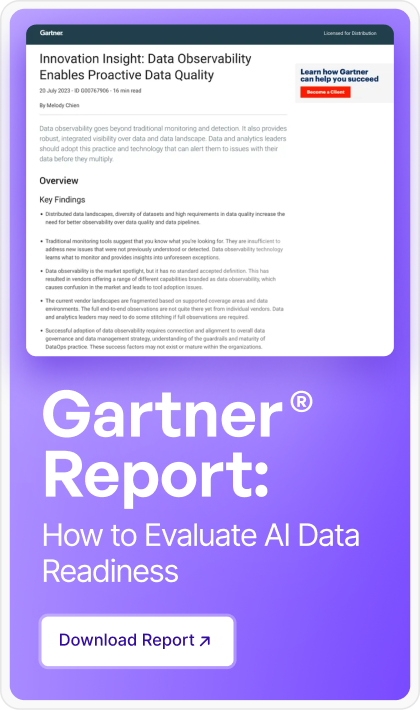Data can be your greatest asset or your biggest liability. Today, unreliable data can lead to costly mistakes and missed opportunities. Traditional data management practices cannot ensure the quality and trustworthiness of your data. This is where data observability makes the difference. Data observability empowers organizations to trust their data at every stage by offering deep insights into data pipelines and processes.
In this article, we’ll explore how data observability enhances data reliability and why Acceldata’s platform is your best ally in this pursuit.
What Is Data Observability?
Data observability refers to the comprehensive approach of gaining visibility into data across its lifecycle, from ingestion to ultimate consumption. It involves monitoring, tracking, and understanding the state of data to ensure its quality and data reliability throughout its journey.
Data observability plays a key role in enterprise data management. It helps ensure data remains trustworthy and actionable. Clear visibility into data processes is crucial for maintaining data quality, enabling early detection of issues, and ensuring smooth operations, especially considering the rising complexity of data environments due to the presence of various pipelines and platforms.
Role of Data Readability in Data Observability
Understanding data readability
Data readability refers to how easily data can be interpreted and utilized by humans and machines. It is a key aspect of data observability, as it ensures that the data is structured, labeled, and formatted in an understandable and accessible manner.
Benefits of data readability for organizations
Enhanced data readability allows for more efficient decision-making, as stakeholders can quickly comprehend and act on data insights. It also accelerates data processing and analysis, enabling faster responses to business needs. Furthermore, improvement in data readability fosters better collaboration across teams.
Consider a global retail company that has implemented data readability practices to streamline its operations. By improving data readability, the company's marketing team can easily interpret customer behavior data, allowing it to quickly adjust promotional strategies. This will lead to an increase in sales during key shopping seasons, as the team can make data-driven decisions faster and with more confidence. Additionally, the collaboration between marketing and IT will improve significantly, as both teams can easily access and understand the same data, leading to more synchronized efforts across the organization.
How Data Observability Enhances Data Readability for Organizations
Data observability tools and practices improve data readability by providing real-time insights into the state of data, reducing complexity, and presenting information in more understandable formats.
These tools ensure that data remains consistent, well-structured, and free from errors, making it more accessible and actionable for all stakeholders. For instance, Acceldata’s platform provides dashboards and alerts that help identify readability issues early, allowing teams to address them proactively. This, in turn, makes data more understandable for both technical users and business leaders, thus bridging the gap between data and decision-making.
Key benefits of data observability:
- Enhanced data quality
Data observability tools continuously monitor data quality, detecting anomalies, inconsistencies, and errors. This proactive approach helps ensure that data remains accurate and reliable, thus reducing the risk of incorrect analysis and decisions. - Improved pipeline reliability
Observability practices ensure that data pipelines remain consistent and reliable, preventing data loss, duplication, or delays. This is particularly important in environments where data flows between multiple systems and platforms. - Performance optimization
Data observability helps identify bottlenecks and inefficiencies by providing insights into system performance. This enables organizations to optimize their data processes, improving overall performance and resource utilization.
How to Implement Data Observability in Your Enterprise
Tools and techniques
Organizations need the right tools to successfully implement data observability. Additionally, integration of observability into data workflows requires adoption of techniques such as automated alerts, real-time dashboards, and data lineage tracking. Acceldata’s platform offers comprehensive features covering data monitoring, anomaly detection, and performance tracking.
Best practices
- Start by defining clear objectives for data observability
- Select tools that align with your specific needs and integrate well with your existing data infrastructure
- Train your teams to use observability tools effectively, ensuring they understand how to interpret the insights provided
Some Use Cases of Data Observability for Organizations
Here are some use cases of data observability:
Improving data quality in financial services
Financial institutions are highly regulated and require accurate data for financial reporting. Implementation of data observability tools can help banks monitor their data pipelines in real-time, quickly identifying discrepancies and resolving issues.
For example, institutions can detect a pattern of errors in transaction data that could have led to inaccurate financial statements. Adoption of data observability tools can help institutions rectify the issue immediately, resulting in improved reporting accuracy and ensuring compliance with stringent financial regulations.
Enhancing pipeline reliability in e-commerce and retail industries
E-commerce and retail businesses struggle with maintaining data pipeline reliability during peak shopping periods. Data observability tools can help monitor their data flow and identify bottlenecks in real time. During a major sales event, observability tools would be able to detect a slowdown in some processes, such as order processing, due to the surge in customer transactions.
Prompt resolution of the issue can help businesses ensure a smoother and faster shopping experience for customers, ultimately reducing cart abandonment rate and increasing sales.
Optimizing performance in healthcare data systems
Healthcare providers may face challenges in delivering timely patient care due to delays in accessing critical patient information. Integration of data observability into healthcare data systems can help organizations monitor and optimize data pipelines.
For instance, observability tools can alert providers about the lag in data flow between medical devices and the central system. By resolving the issue swiftly, doctors can gain timely access to vital patient data, thus improving patient outcomes and enhancing the overall efficiency of the healthcare system.
Ensuring data compliance in the insurance industry
Insurance companies need to maintain regulatory compliance across multiple data platforms, each with its own set of standards and requirements. Deployment of data observability tools can enable companies to continuously track and manage data to ensure it meets industry regulations.
For instance, observability tools can help businesses identify non-compliant data formats in claims processing, which might have resulted in fines. Companies can ensure compliance by rectifying these issues in real time, thus avoiding penalties and preserving their reputation in the industry.
Why choose Acceldata for data observability
Acceldata’s platform provides end-to-end visibility into your data quality processes. Its key features include automated monitoring, customizable alerts, anomaly detection, and comprehensive dashboards that offer actionable insights. The Acceldata observability platform helps make data pipelines more reliable. It enables organizations to detect issues early and maintain high data quality.
Harnessing the Full Potential of Data Observability with Acceldata’s Platform
Maximizing data reliability isn't just about monitoring— it's about understanding and acting on your data in real time. Data observability tools ensure the trustworthiness of your data, the reliability of your pipelines, and confident, data-driven decisions for your enterprise. Acceldata’s platform can help your organization unlock the full potential of data observability.
Enhancing Data Management with Acceldata
Implementing data observability practices allows organizations to significantly improve data quality, data reliability, pipeline performance, and regulatory compliance. Businesses across different sectors can benefit immensely from it. Acceldata’s platform is a robust solution for businesses striving to strengthen their data observability strategies and achieve reliable, accurate, and actionable insights from their data.
Summary
By implementing data observability practices, organizations can significantly improve data quality, pipeline performance, and compliance. The article also showcased real-world examples of how businesses across different sectors benefit from data observability. Acceldata’s platform stands out as a robust solution for companies looking to strengthen their data observability strategies and achieve reliable, accurate, and actionable insights from their data.














.webp)
.webp)


